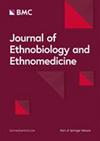中国云南省西双版纳农田保护水稻品种的民族植物学研究
IF 2.9
2区 医学
Q1 BIODIVERSITY CONSERVATION
引用次数: 0
摘要
地貌、文化和土地品种之间存在着复杂的相互作用和相互影响,水稻文化就是这种关系的典型体现。在保护传统习俗的同时,也要保护土地品种。西双版纳地区是陆稻遗传多样性的中心,拥有丰富的遗传资源。尽管该地区水稻资源丰富多样,但尚未开展全面系统的研究。2023 年 10 月至 11 月,我们在西双版纳的勐海、勐腊和景洪等 18 个乡镇收集了农田保护下的水稻陆稻品种。通过半结构式访谈和各种方法,我们调查了影响该地区水稻陆稻品种保存和损失的因素。我们对收集到的当地水稻的农艺性状进行了统计分析,将籼稻或粳稻、糯稻或非糯稻、谷粒形状和谷壳颜色作为第二类性状。第二类性状包括千粒重和粒长等数量性状。使用香农-维纳指数评估了不同地区、不同性状和不同族群之间的水稻多样性。此外,通过 UPGMA 方法进行的聚类分析也描述了资源的分布特征。在西双版纳地区共收集到 70 个水稻陆稻品种,每个品种都表现出不同的特征。不同地区、不同性状、不同命名和不同族群之间均存在差异。多样性分析表明,勐腊的多样性最高,其次是勐海,而景洪的多样性最低。第二类性状的多样性高于第一类性状,傣族糯米的多样性高于其他民族。聚类分析将 70 个样本分为 7 组,遗传距离为 1.15。民族植物学访谈强调了西双版纳水稻陆稻资源的快速流失,而土著民族文化在水稻陆稻资源的保护中发挥着至关重要的作用。尤其是傣族传统文化,在保护糯稻资源方面发挥了至关重要的作用,体现了傣族文化与糯稻之间的相互依存关系。西双版纳丰富的自然环境和多元的民族文化孕育了各种水稻品种。傣族是糯稻的主要种植者,糯稻的多样性较高,傣族将其传统民族文化与糯稻资源保护紧密结合在一起。同时,糯稻资源的保护也促进了傣族文化的传承。然而,水稻陆稻品种正面临着失传的风险。因此,收集和记录水稻品种至关重要。鼓励当地社区维持和扩大种植,促进农场保护。这些措施为水稻育种提供了宝贵的种质和基因,同时也是一种文化保护手段。本文章由计算机程序翻译,如有差异,请以英文原文为准。
Ethnobotanical studies on rice landraces under on-farm conservation in Xishuangbanna of Yunnan Province, China
A complex interaction and mutual influence exists among landscapes, cultures, and landraces, with rice culture being a typical embodiment of this relationship. The conservation of landraces operates alongside preserving traditional practices. The Xishuangbanna region stands out as a hub for the genetic diversity of landraces, boasting rich genetic resources. Despite the diverse rice resources in this region, a comprehensive and systematic study has not been undertaken. From October to November 2023, we collected rice landraces under the on-farm conservation in 18 townships including Menghai, Mengla and Jinghong in Xishuangbanna. Employing semi-structured interviews and various methods, we investigated factors influencing the preservation and loss of rice landraces in the region. Statistical analysis was applied to the agronomic traits of collected local rice, encompassing indica or japonica, glutinous or non-glutinous, grain shape, and hull color as second category traits. The second category included quantitative traits like thousand grain weight and grain length. Rice diversity among different regions, traits, and ethnic groups was assessed using the Shannon–Wiener index. Additionally, clustering analysis via the UPGMA method depicted the distribution characteristics of the resources. A total of 70 rice landraces were collected in the Xishuangbanna region, each exhibiting distinct characteristics. Differences were observed across regions, trait, naming, and ethnic groups. Diversity analysis revealed that Mengla had the highest diversity, followed by Menghai, while Jinghong exhibited the lowest diversity. The second category of traits displayed broader diversity than the first, with the Dai people’s glutinous rice showcasing greater diversity than other ethnic groups. Cluster analysis categorized the 70 samples into seven groups at a genetic distance of 1.15. Ethnobotanical interviews emphasized the rapid loss of rice landraces resources in Xishuangbanna, with indigenous ethnic cultures playing a vital role in the conservation of rice landraces. Dai traditions, in particular, played a crucial role in protecting glutinous rice resources, showcasing a mutual dependence between Dai culture and glutinous rice. The rich natural environment and diverse ethnic cultures in Xishuangbanna have given rise to various rice landraces. The Dai, primary cultivators of glutinous rice with higher diversity, intertwine their traditional ethnic culture with the conservation of glutinous rice resources. At the same time, the preserving glutinous rice resources promotes the inheritance of Dai ethnic culture. However, rice landraces are facing the risk of loss. Hence, collecting and documenting rice landraces is crucial. Encourage local communities to sustain and expand their cultivation, promoting on-farm conservation. These measures contribute valuable germplasm and genes for rice breeding and serve as a means of cultural preservation.
求助全文
通过发布文献求助,成功后即可免费获取论文全文。
去求助
来源期刊

Journal of Ethnobiology and Ethnomedicine
PHARMACOLOGY & PHARMACY-
CiteScore
7.30
自引率
16.70%
发文量
66
审稿时长
>12 weeks
期刊介绍:
Journal of Ethnobiology and Ethnomedicine publishes original research focusing on cultural perceptions of nature and of human and animal health. Journal of Ethnobiology and Ethnomedicine invites research articles, reviews and commentaries concerning the investigations of the inextricable links between human societies and nature, food, and health. Specifically, the journal covers the following topics: ethnobotany, ethnomycology, ethnozoology, ethnoecology (including ethnopedology), ethnogastronomy, ethnomedicine, ethnoveterinary, as well as all related areas in environmental, nutritional, and medical anthropology.
Research focusing on the implications that the inclusion of humanistic, cultural, and social dimensions have in understanding the biological word is also welcome, as well as its potential projections in public health-centred, nutritional, and environmental policies.
 求助内容:
求助内容: 应助结果提醒方式:
应助结果提醒方式:


